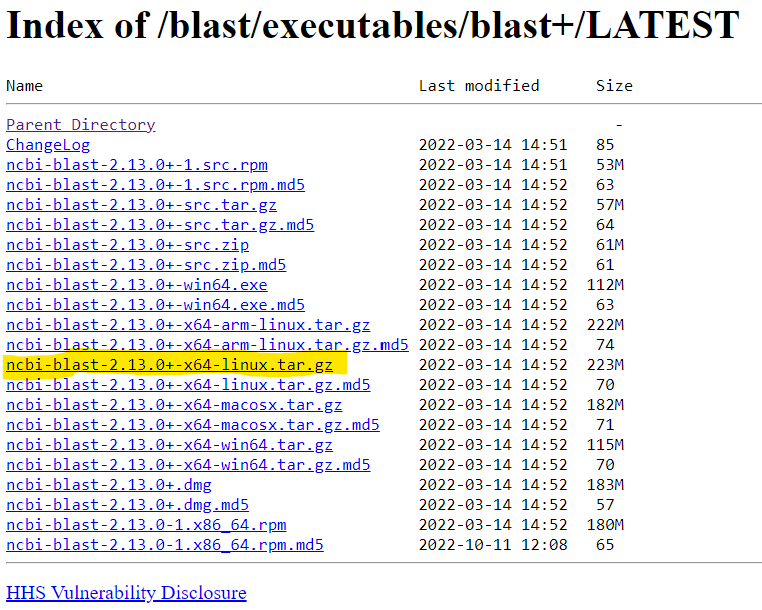This assignment is to take set of unknown protein sequences, and
annotate them with GO terms. What is a Gene Ontology (GO) term? 👀 see
this [introduction to GO
annotation](http://geneontology.org/docs/go-annotations/).
tl;dr: GO term annotation helps to answer questions like, ’What proteins
are in the sample, and what do they do?”
> My Environment:
>
> - Windows Surface Pro
>
> - Chrome browser
>
> - [JupyterHub
> Instance](https://jupyter.rttl.uw.edu/2023-spring-fish-546-a),
> remote RStudio server
### Step 1. Download Software
Open the remote RStudio server through
JupyterHub Instance.
Navigate to the
NCBI blast downloads
page, and copy the link to the software ***for your operating
system***. This is an important first step! Here I choose
\`[ncbi-blast-2.13.0+-x64-linux.tar.gz](https://ftp.ncbi.nlm.nih.gov/blast/executables/blast+/LATEST/ncbi-blast-2.13.0+-x64-linux.tar.gz)\`
because I am working in a Linux OS environment through the cloud
instance of UW’s JupyterHub, which operates a Linux OS.

We are going to first try to downloaded the
[ncbi-blast-2.13.0+-x64-linux.tar.gz](https://ftp.ncbi.nlm.nih.gov/blast/executables/blast+/LATEST/ncbi-blast-2.13.0+-x64-linux.tar.gz)
, and we’ll do this not by ‘clicking’ on the file and downloading it
locally to your computer, but by downloading it using the `curl -O` bash
command and placing it in a new folder we’ll create named ‘applications’
outside of the repository.
> Note: When you start a bash code chunk the present working directory
> always starts over in the location of the file that you are working
> from
# check present working directory
pwd
Download the software using `curl -O`
# navigate to outside of git repo directory using relative paths
cd ../../../../
# make application directory (will throw an error if already made once
# comment out `mkdir applications` if this is the case)
# mkdir applications
# switch into applications directory
cd applications
# curl (download from the internet) the NCBI software
curl -O https://ftp.ncbi.nlm.nih.gov/blast/executables/blast+/LATEST/ncbi-blast-2.13.0+-x64-linux.tar.gz
# tar unzip software with `tar -xf`
tar -xf ncbi-blast-2.13.0+-x64-linux.tar.gz
> Note: The `~` command specifies a file to run a program or command on…
> it does not change you to that directory space! The `-h` command
> displays help when placed after a specified file
~/applications/ncbi-blast-2.13.0+/bin/blastx -h
### Step 2. Make Blast Database
Before this step we want to make sure there is an assignments/data
directory, and to add `assignments/data/*.f*` to the .gitignore file,
since we will be downloading large fasta files to the folder, these
files are too large to commit to GitHub (exceeding the max file size),
and will result in errors if not included in the .gitignore file.
> Note: add `assignments/data/*.f*` to the .gitignore file
👀 see .
What is Swiss-Prot (sprot)? 👀 see
[this](https://www.uniprot.org/help/uniprotkb_sections) info article.
# change into assignments/data directory
cd ../data
# download fasta.gz files from uniprot
curl -O https://ftp.uniprot.org/pub/databases/uniprot/current_release/knowledgebase/complete/uniprot_sprot.fasta.gz
# use the 'move' `mv` command to rename uniprot_sprot to include info on year & assignment number
mv uniprot_sprot.fasta.gz uniprot_sprot_r2023_01.fasta.gz
# unzip file (zipped by `gz`.. so unzip with `gunzip`..something something)
gunzip -k uniprot_sprot_r2023_01.fasta.gz
# list the files in the data directory to check that they are there with the right names
ls ../data
This code chunk will make the blast database.
> Note: add `assignments/blastdb` to the .gitignore file
# Use the ncbi-blast software 'makeblastdb' and run chain of commands to make a database using the fasta files in a new blastdb folder
~/applications/ncbi-blast-2.13.0+/bin/makeblastdb \
-in ../data/uniprot_sprot_r2023_01.fasta \
-dbtype prot \
-out ../blastdb/uniprot_sprot_r2023_01
### Step 3. Get Query Sequence
curl https://eagle.fish.washington.edu/cnidarian/Ab_4denovo_CLC6_a.fa \
-k \
>../data/Ab_4denovo_CLC6_a.fa
head ../data/Ab_4denovo_CLC6_a.fa
echo "How many sequences are there?"
grep -c ">" ../data/Ab_4denovo_CLC6_a.fa
### Step 4. Run Blast
This code chunk takes a very long time to run! May have to let it write
to a file for a little while, then interrupt the code chunk by
restarting R and moving on to the next step.
~/applications/ncbi-blast-2.13.0+/bin/blastx \
-query ../data/Ab_4denovo_CLC6_a.fa \
-db ../blastdb/uniprot_sprot_r2023_01 \
-out ../output/Ab_4-uniprot_blastx.tab \
-evalue 1E-20 \
# 16 because 16 CPU cores on my machine
-num_threads 16 \
-max_target_seqs 1 \
-outfmt 6
> Tip: run the head command to make sure there is an output.
head -2 ../output/Ab_4-uniprot_blastx.tab
wc -l ../output/Ab_4-uniprot_blastx.tab
Need to convert `sp|Q08013|SSRG_RAT` to get accession number out.
### Step 5. Getting More Information
First need to change format of blast output in bash…
tr '|' '\t' < ../output/Ab_4-uniprot_blastx.tab \
> ../output/Ab_4-uniprot_blastx_sep.tab
In R chunks…
Install packages
install.packages(tidyverse)
install.packages("kableExtra")
Attach packages
library(tidyverse)
library("kableExtra")
Read in data
bltabl <- read.csv("../output/Ab_4-uniprot_blastx_sep.tab", sep = '\t', header = FALSE)
spgo <- read.csv("https://gannet.fish.washington.edu/seashell/snaps/uniprot_table_r2023_01.tab", sep = '\t', header = TRUE)
Check data
head.matrix(spgo)
str(bltabl)
### **Step 6. Joining blast table with annotation table**
At this point we have a blast output table (bltabl) and annotation table
(spgo) both with a Uniprot accession number. Thus we can join the two
tables and be able to get more functional information about the genes.
Join spgo and bltabl:
1. join using left\_join
left_join(bltabl, spgo, by = c("V3" = "Entry")) %>%
select(V1, V3, V13, Protein.names, Organism, Gene.Ontology..biological.process., Gene.Ontology.IDs) %>% mutate(V1 = str_replace_all(V1,
pattern = "solid0078_20110412_FRAG_BC_WHITE_WHITE_F3_QV_SE_trimmed", replacement = "Ab")) %>%
write_delim("../output/blast_annot_go.tab", delim = '\t')
1. join using left\_join and display using kbl
kbl(
head(
left_join(bltabl, spgo, by = c("V3" = "Entry")) %>%
select(V1, V3, V13, Protein.names, Organism, Gene.Ontology..biological.process., Gene.Ontology.IDs) %>% mutate(V1 = str_replace_all(V1,
pattern = "solid0078_20110412_FRAG_BC_WHITE_WHITE_F3_QV_SE_trimmed", replacement = "Ab"))
)
) %>%
kable_styling(bootstrap_options = c("striped", "hover", "condensed", "responsive"))
annot_tab <- read.csv("../output/blast_annot_go.tab", sep = '\t', header = TRUE)
kbl(
(annot_tab)
)%>%
kable_styling(bootstrap_options = c("striped", "hover", "condensed", "responsive"))